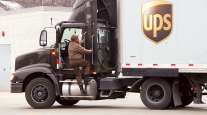UPS Posts 10% Gain in 3Q Profit
This story appears in the Nov. 3 print edition of Transport Topics.
UPS Inc. said that third-quarter profit rose 10% from a year ago and that it is on track for upgrading its operational network to meet an expected 11% rise in holiday shipments.
Net income rose to $1.21 billion, or $1.32 per share, from $1.1 billion, or $1.16, a year earlier. Revenue rose 5.7% to $14.3 billion, the package company reported Oct. 24.
UPS said it anticipates handling more than 585 million packages in December for the holidays — up 11% over last year, when its network was overwhelmed by last-minute online orders right before Christmas that led to widespread delivery problems.
The carrier’s peak delivery day will be Dec. 22, when it expects to deliver more than 34 million packages worldwide. Six days are likely to surpass last year’s single-day delivery record of 31 million packages, UPS said Oct. 29.
CEO David Abney said UPS has added a full operating day on Black Friday, is bringing 49 additional hub sources online and will have 47 new expanded or temporary facilities operating around the country for the holiday season.
“This added capacity provides the flexibility to handle higher volumes more efficiently,” Abney said in a conference call with analysts.
He said UPS has expanded one facility near Los Angeles and two in the Houston area, opened two new buildings in Dallas and made operational improvements at its two largest facilities, its Worldport air hub in Louisville, Kentucky, and its Chicago-area consolidated hub, a large logistics center.
UPS, which ranks No. 1 on the Transport Topics Top 100 list of the largest U.S. and Canadian for-hire carriers, delivers about 17 million packages on an average day.
Its supply chain and freight unit’s operating profit rose 7% to $215 million, while revenue improved 7.4% to $2.4 billion.
Less-than-truckload UPS Freight, part of that unit, saw its revenue rise 7.9% to $810 million on 4.7% higher LTL shipments. Revenue per hundredweight improved 1.1%, and the unit’s operating profit and margin expanded from a year ago.
UPS does not disclose the operating profit of UPS Freight, but one analyst said last week that, while tonnage growth accelerated from year-to-date trends, revenue per hundredweight decelerated.
“We believe this may have been due to an increase in bundling activity, which would be a negative [in] the LTL sector,” David Ross, an analyst with Stifel, Nicolaus & Co., wrote in an investors note.
“Bundling is where you sell more than one service together, but if you buy more than one, you get some kind of a break,” Ross told Transport Topics.
“LTL and parcel are the two products that [UPS] and FedEx have talked about bundling in the past,” he said. “When you bundle, there’s always some kind of discount involved. Often, that might be LTL, so they can get the parcel business, which is more profitable for them, anyway.”
Ross said bundling could be “a negative for the pricing environment because, if everybody else is selling it at one price and you’re selling at a discount, that will have negative price pressure” in the LTL sector.
UPS’ parcel business im-proved in the quarter, with domestic package operating profit rising 7.8% to $1.3 million.
Revenue rose 5.3% to $8.7 billion as daily package volume rose 6.9%, led by its UPS Ground and deferred-products segments, although total revenue per package declined by 1.5%.
Its international package operating profit jumped 10.3% to $460 million, with revenue up 5.5% year-over-year to $3.2 billion. Export products rose 9.4%, and shipments out of Asia rose 16%, while those from Europe rose 14%.
As for an annual outlook, Chief Financial Officer Kurt Kuehn said UPS was holding its full-year adjusted earnings estimate at $4.90 to $5 per share, which is 7% to 9% higher than last year.
Stifel’s Ross said he was “generally pleasantly surprised” with UPS’ results. “The third-quarter economy was pretty strong. Does that mean it will be pretty strong a year from now? No, but the most recent data we have looks pretty good.”
Regarding the upcoming holiday season, Ross said UPS “answered it as best they could, but they’re planning for an unknown peak period. Just like last year, they thought they had a plan and were going to be able to handle it, but the volume wildly exceeded their plan.
“This year, they think they have a better plan and will be able to hit it — maybe they will, but maybe they won’t; that’s the problem with planning to a forecast. If it’s too much of a degree outside, it becomes an issue,” he said.




